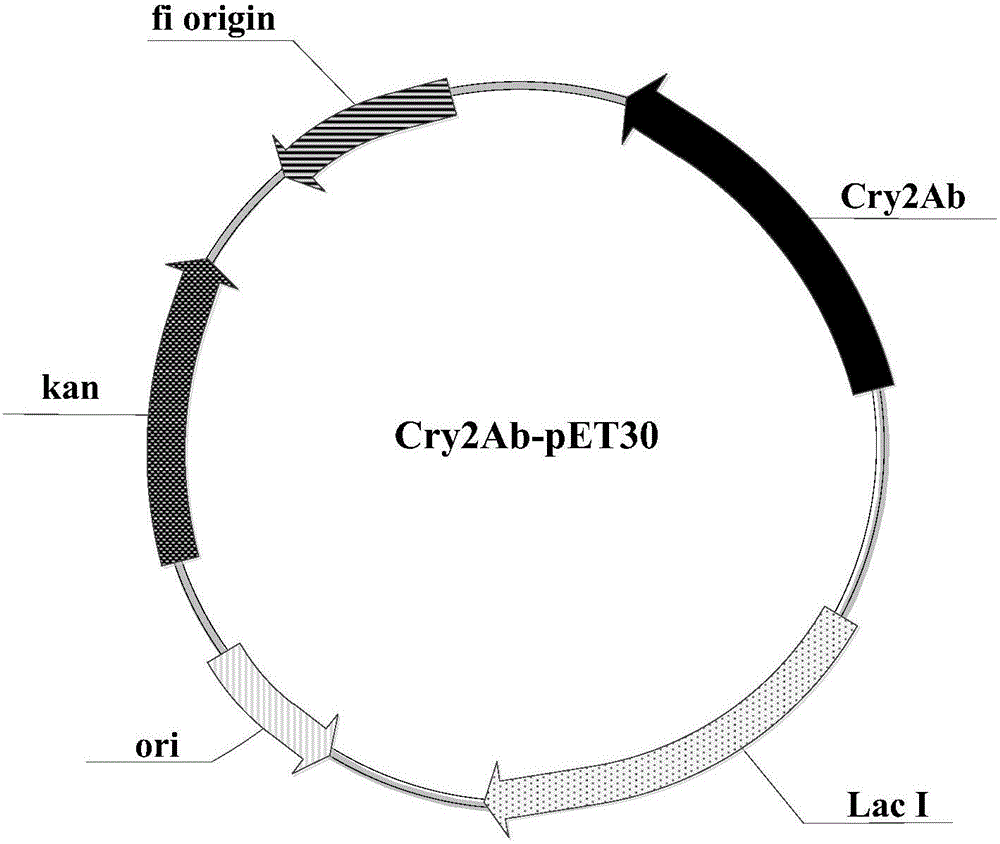Insecticide protein composition and method thereof for managing insect resistance
An insect resistance and protein technology, applied in the fields of pesticides, chemical instruments and methods, and botanical equipment and methods, can solve problems such as poor sustainability, lower total yield, and cumbersome farmers' actual operation.
- Summary
- Abstract
- Description
- Claims
- Application Information
AI Technical Summary
Problems solved by technology
Method used
Image
Examples
no. 1 example
[0088] The first embodiment, expression, purification and activation of Cry2Ab protein
[0089] 1. Construction of recombinant expression vector containing Cry2Ab nucleotide sequence
[0090] The amino acid sequence (634 amino acids) of the Cry2Ab insecticidal protein is shown in SEQ ID NO: 1 in the sequence listing; the nucleotide sequence of the Cry2Ab insecticidal protein is optimized according to the codon preference of Escherichia coli, and the code corresponding to The Cry2Ab nucleotide sequence (1905 nucleotides) of the amino acid sequence of the Cry2Ab insecticidal protein is shown in SEQ ID NO:3 in the sequence listing.
[0091] The Cry2Ab nucleotide sequence (shown as SEQ ID NO: 3 in the sequence listing) was synthesized by Nanjing GenScript Biotechnology Co., Ltd., and the structural representation of the recombinant expression vector Cry2Ab-pET30 constructed therefrom is shown in figure 1 Shown (wherein, Kan represents the kanamycin resistance gene; f1 represents ...
no. 2 example
[0112] Second embodiment, bioassay of Bt-sensitive corn borer strain and corn borer-resistant strain (Cry1Ab protein)
[0113] 1. The source of the tested insects
[0114] The tested insects were the Bt-sensitive strain of Ostrinia furnacalis (hereinafter referred to as ACB-BtS to represent the Bt-sensitive strain of Ostrinia furnacalis) and the Bt-resistant strain of Asian corn borer (Ostrinia furnacalis) (hereinafter referred to as ACB-BtS). AbR represents the Asian corn borer Bt-resistant strain Ab0.8, that is, the Asian corn borer Bt-resistant strain subcultured with feed with a Cry1Ab concentration of 0.8 μg / g), and the insects of the above two strains are from China Institute of Plant Protection, Academy of Agricultural Sciences.
[0115] 2. Bioassay method for Asian corn borer
[0116]Bioassays were performed with different concentrations for each Bt protein, the concentration range of Cry1Ab protein was 0 μg / g to 50 μg / g, and the concentration range of Cry2Ab protein...
no. 3 example
[0127] The third embodiment, the application of Cry2Ab protein and Cry1Ab protein in the production of insect-resistant transgenic plants
[0128] According to the experimental results of the second embodiment, the Cry2Ab protein and the Cry1Ab protein are expected to be used for combined expression in transgenic plants such as corn plants to delay or prevent O. corn borer from developing resistance to the plant.
[0129] The first method is sequential transformation: where a plant transformed with a first gene (eg the Cry1Ab gene) is retransformed to introduce a second gene (eg the Cry2Ab gene). This sequential transformation preferably uses two different selectable marker genes, eg a kanamycin resistance gene and a phosphinothricin acetyltransferase gene (eg pat or bar gene) conferring resistance to the glufosinate herbicide.
[0130] The second method is the co-transformation method: the nucleotide sequence encoding the Cry1Ab protein is expressed in plants together with th...
PUM
 Login to View More
Login to View More Abstract
Description
Claims
Application Information
 Login to View More
Login to View More - R&D
- Intellectual Property
- Life Sciences
- Materials
- Tech Scout
- Unparalleled Data Quality
- Higher Quality Content
- 60% Fewer Hallucinations
Browse by: Latest US Patents, China's latest patents, Technical Efficacy Thesaurus, Application Domain, Technology Topic, Popular Technical Reports.
© 2025 PatSnap. All rights reserved.Legal|Privacy policy|Modern Slavery Act Transparency Statement|Sitemap|About US| Contact US: help@patsnap.com



